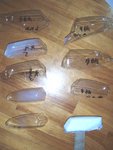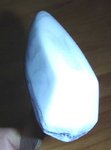Navigation
Install the app
How to install the app on iOS
Follow along with the video below to see how to install our site as a web app on your home screen.
Note: This feature may not be available in some browsers.
More options
You are using an out of date browser. It may not display this or other websites correctly.
You should upgrade or use an alternative browser.
You should upgrade or use an alternative browser.
bending acetate
- Thread starter don51o
- Start date
Ad: This forum contains affiliate links to products on Amazon and eBay. More information in Terms and rules
More options
Who Replied?Airframes
Benevolens Magister
Do you mean clear acetate sheet? If so, it can be a little difficult, even with heat treatment, though not impossible, due to the chemical composition of acetate. However, if it's clear plastic (styrene) sheet, available from model shops, then heat works. It's a bit complex to explain without diagrams, but fairly simple to do! Of course, it depends what shape you want, and it's normally better to make a male and female mould, from balsa block, or Milliput, and balsa sheet or similar.
Plastic (styrene) card, the plain white stuff, can be handled the same way.
If this is what you are trying to do, let me know, and I'll post some sketches explaining the process(s). I'd need to know the sort of shape you want to form/bend, BTW.
Plastic (styrene) card, the plain white stuff, can be handled the same way.
If this is what you are trying to do, let me know, and I'll post some sketches explaining the process(s). I'd need to know the sort of shape you want to form/bend, BTW.
Like this? I used pieces of clear PET plastic sheet (one that used for bottles). Avoid overheating as it will cause whitening as you can see. As for the mold I first carved it with knives and sand papers from a wooden block. Then copied it with scilicone rubber and re-cast the new mold with polyester resin for the easiness of surface polishing each time after the mold is trimmed and/or filed.
Attachments
Captain Dunsel
Airman 1st Class
FWIW, the blemish from overheating won't always show up right away. On the Harrow in my avatar, I wound up with a small blemish on the cockpit canopy, but not until it was already glued in and too late to remove. Of course, it's right in front of the aircrew...
Before anyone suggests it, I tried the oil cure for CA fogging, from the inside and outside, and it didn't work, so it isn't from using CA.
CD
Before anyone suggests it, I tried the oil cure for CA fogging, from the inside and outside, and it didn't work, so it isn't from using CA.
CD
Airframes
Benevolens Magister
Yep, that's the way Popsie.
The fogging is caused by the reaction, vaguely mentioned in my first reply. Acetate, and PET (Polyethelene tablet) have a different composition to straight polystyrene, and can exhibit clouding, discolouration, and shrinking. It can also turn brittle much more quickly than 'styrene, particularly in sunlight or a strong UV light source.
Although costing a little more, it is better to use 'styrene, and of a slightly thicker gauge than possibly required, as styrene, rather than shrinking with the application of heat, will stretch slightly. This actually allows the approximate thickness required, as the 'stretching' takes the form of thinning of the sheet.
Whichever material is used, the application of heat needs to be done carefully, and normally takes practice. Even then, I expect a success rate of one in three, at best, 50%, from each moulding attempt.
I've found that, although it is possible to make the male mould from materials such as silicone or 'Milliput', it is better to use balsa wood, with the grain filled and polished, using a mixture of gloss varnish and talcum powder. When enough coats are applied, with the penulitimate coat lightly sanded and a further coat of clear varnish applied and polished when hard, this minimizes any reaction that might cause fogging or the 'white' reaction. I believe that most of this is caused by a reaction with the alternative materials, which doesn't seem to happen with the 'traditional' balsa mould. The latter also last a very, very long time - I still have some made over 30 years ago.
The fogging is caused by the reaction, vaguely mentioned in my first reply. Acetate, and PET (Polyethelene tablet) have a different composition to straight polystyrene, and can exhibit clouding, discolouration, and shrinking. It can also turn brittle much more quickly than 'styrene, particularly in sunlight or a strong UV light source.
Although costing a little more, it is better to use 'styrene, and of a slightly thicker gauge than possibly required, as styrene, rather than shrinking with the application of heat, will stretch slightly. This actually allows the approximate thickness required, as the 'stretching' takes the form of thinning of the sheet.
Whichever material is used, the application of heat needs to be done carefully, and normally takes practice. Even then, I expect a success rate of one in three, at best, 50%, from each moulding attempt.
I've found that, although it is possible to make the male mould from materials such as silicone or 'Milliput', it is better to use balsa wood, with the grain filled and polished, using a mixture of gloss varnish and talcum powder. When enough coats are applied, with the penulitimate coat lightly sanded and a further coat of clear varnish applied and polished when hard, this minimizes any reaction that might cause fogging or the 'white' reaction. I believe that most of this is caused by a reaction with the alternative materials, which doesn't seem to happen with the 'traditional' balsa mould. The latter also last a very, very long time - I still have some made over 30 years ago.
Matt308
Glock Perfection
Brilliant!
Users who are viewing this thread
Total: 1 (members: 0, guests: 1)


